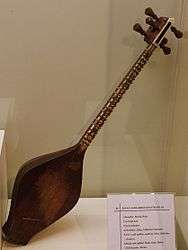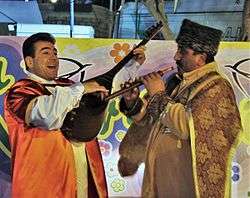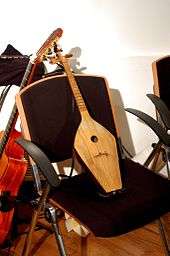Choghur
|
Choghur in National Museum of History of Azerbaijan | |
| String instrument | |
|---|---|
| Other names | chaghyr, chagur, chugur, chonguri, chungur, chunguri |
| Classification | Plucked |
| Related instruments | |
The choghur[1] (Azerbaijani: Çoğur; Georgian: ჩონგური) is a plucked string musical instrument common in Azerbaijan and Georgia. It has 4 nylon strings.[2][3][4]
The choghur dates back to the 12th to 16th centuries, the period between the gopuz and the saz. In the Caucasus, Iran and Anatolia, and in Sufi traditions, darvishes and ashugs used an instrument called the "chaghyr" /"chagur"/ "chugur" / "choghur" / "chungur". Presumably, the name "choghur" means "the musical instrument used to appeal to God and truth". [In Azerbaijani the word "chaghir" means "to call", "to appeal"] It may be assumed that the name of the instrument originates from the expression "chal-chaghyr" (festivity or celebration), which was later changed to "choghur". Various historical sources indicate that the choghur was used to create a high battle spirit among the soldiers of the medieval Safavid state's army.
In the "Jahanarai Shah Ismayil Safavi" annals, describing the situation at the beginning of the 16th century, several lines are devoted to such an occasion: "At the head of the victoriously striding army, chukurs played and Turks-Varsakgs sang in order to raise the battle spirit of the warriors."
In his work "Turkmen Times in the South", Ali Reza Yalchin tells about the nine strings, 15 frets and perfect timbre of the choghur.16 It is possible to conclude from historical facts that in the 12th-13th centuries, the choghur replaced the ozan gopuz, and in the 15th-16th centuries, the choghur was replaced by the saz. But some versions of the choghur that were spread throughout the Caucasus and among the Iraqi Turkmens have survived until the present.
The 19th-century choghur stored in the Azerbaijan History Museum has three pairs of strings and 22 frets on its neck. The body of this instrument is made of mulberry wood.. The top of the body has a wooden covering that is four mm thick. The neck and head of the instrument are made of nut wood, the pegs of pear wood.
The total length of the instrument is 880 mm. The body is 400 mm long, 225 mm wide and 140 mm tall. Two resonator apertures are drilled on each side of the body, and several apertures are made on top of the sounding board. Its scale goes from the "do" of the small octave to the "sol" of the second octave.
References
- ↑ Jean During. The spirit of sounds: the unique art of Ostad Elahi. 2003. P. 173.
An excellent Azerbaijani lute (choghur), which he played less toward the end of his life
- ↑ Atlas of Plucked Instruments - Middle East
- ↑ Georgia, 3rd revised (Bradt Travel Guide) by Tim Burford, ISBN 1-84162-261-3, ISBN 978-1-84162-261-3, pg. 47
- ↑ The Stringed Instrument Database


